Gardens
Raised Bed Gardens
Raised beds are an attractive option for those who want to garden but do not have a lot of space, who have poor soil, or for those unable to withstand the rigors of caring for an in-ground garden. Raised beds can be very small (2 x 2, 3 x 3 feet), or up to 4 feet wide and most desirably, no more than 8 feet long if you use wood as a border. You can stack the borders as high as you want to preclude bending over and stressing your back.
Two simple raised beds I made from a friends old fence boards. I simply cut the boards and screwed them together with deck screws. The boards above are six inches high while the ones below are four inches.
I find raised beds to be highly productive. Our raised beds have always thrived and in the summer of 2008 (at least up until late June when this is written) they have done especially well because they are designed to drain. Baldwin City has had heavy rainfall in the spring and early summer, and that is not such good news for our large in-ground garden nor for Kansas farmers.
Raised beds drain well, which is desirable when you face sustained rain, but drainage can be a drawback when rains stop and dry weather sets in. You must to be diligent about watering in hot months.
How do you construct a Raised Bed?
Beds can be as extravagant and expensive as you want. Some cost thousands of dollars and are made of stone or high priced wood and corner joints. Other beds, however, can be made of common materials that you can locate in junk yards, garage sales and even in your own discarded “stuff” pile behind your garage.
Above: a very basic bed corner. Below: one that will last much longer (from Gardeners.com) and you can stack more boards with this option.
Easier Version
Dig into the ground about a foot to break up the hard soil.
Pile fertile soil (a mix of soft topsoil, Miracle Grow potting soil, peat moss and sand) into foot high mounds if you are planting corn or potatoes (or into a solid rectangular area for other plants such as peppers). However, the challenges with simple mounds include soil washing away because of no boundaries. Also, grass and weeds find it easy to invade your plants’ space.
This method is how we grew Tosh’s Three Sisters garden and the potatoes (see the grass eager to take it over; it is held back with black matting covered with cypress mulch and old-fashioned pulling).
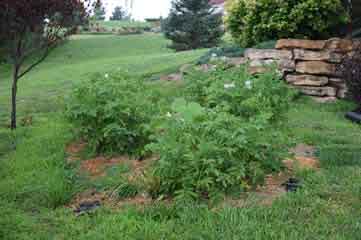
More Successful Versions
Use wood, stones, or railroad ties as boundaries. See from the shots below that I use 2 X 8s and 2 X 4s as borders. I bought my “Stackable Corner Joints” from Gardeners Supply Company.
You do not have to use these joints. You also can buy metal joints from Home Depot, Lowes or other hardware store.
If you use railroad ties, stones, or bricks you don’t have to use joints.
If you use wood, do not buy “pressure treated” wood as the chemicals may leech into your soil.
Below: Looking down on my four raised beds
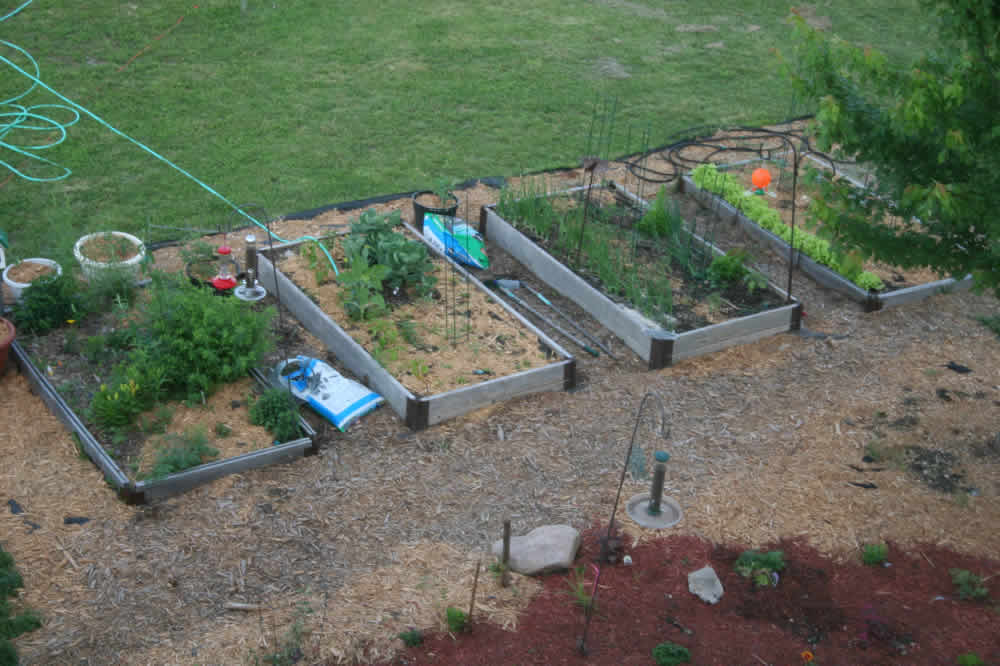
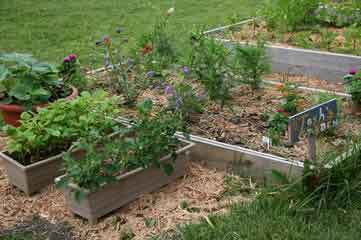

Butterfly garden in foreground; squash, peppers and melons; peppers; 3 Sisters. June 2008;
rt: onions pulled from one of my raised beds, June 2013
Butterfly raised garden with containers of green beans, peppers and melon. June 2008
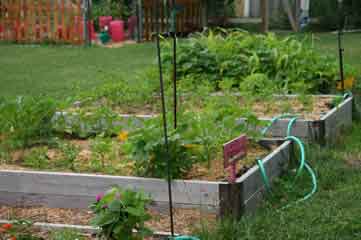
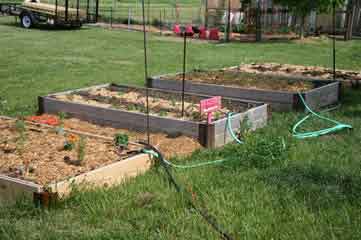
Same gardens, May 2008.
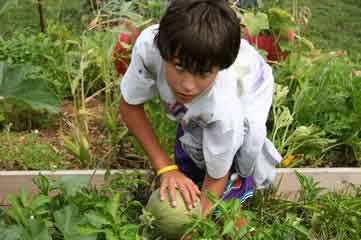
Tosh with cantaloupe in raised bed, August 2006
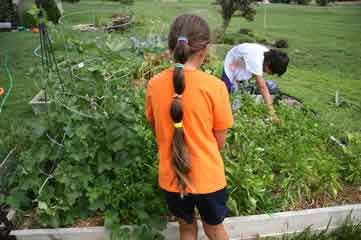
Ari and Tosh looking for peppers in another raised bed, 2006. This bed became overgrown with cucumbers on the west end.
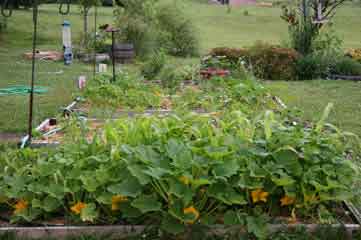
Three Sister in a raised bed, doing well. Late June 2008.
After you select your border, construct it on level ground. What do you fill it with? This is what I put into my raised beds that are 4 x 8 x 1:
(in this order* and use a rake to smooth down)10 bags of topsoil or good soil you have in your yard
15 bags potting soil
Last four inches: mix of 2 bags sand, Miracle Grow Potting soil and Peat Moss.
*some gardeners advise that you first lay down thick layers of newspapers or cardboard to prevent grass from growing up. I have not had grass grow through a foot of soil, but it could happen.
**if you decide to have a garden longer than 8 feet and plan to use wood, be careful that your wood does not bow outwards from the weight of the soil and the water that often with saturate the dirt. You can drive a three-foot length of rebar into the ground next to the wood every four feet to kept the wood straight.
Water:
I use soaker hoes buried in the soil, but you can also use a regular water hose to spray the water.
Mulch:
Be sure to spread either wood chips (I use cedar or cypress) or straw as mulch all around the plants after they are planted (or after the seeds sprout).
Need more information and photos?
Google “Raised Gardens” or slick on to these sites (there are many, these are just examples):
Ed Hume Seeds: http://www.humeseeds.com/vegplan.htm
No Dig Vegetable Garden: http://www.no-dig-vegetablegarden.com/raised-vegetable-garden.html
University of Missouri Extension: http://extension.missouri.edu/xplor/agguides/hort/g06985.htm
Raised Vegetable Gardens: http://www.gardeningknowhow.com/design/raised-vegetable-gardens.htm
Backyard Raised Garden: http://www.eartheasy.com/grow_backyard_vegetable_garden.html